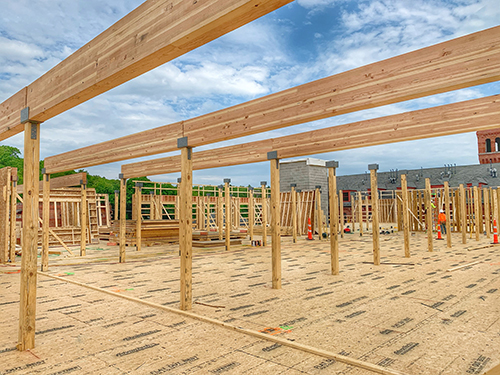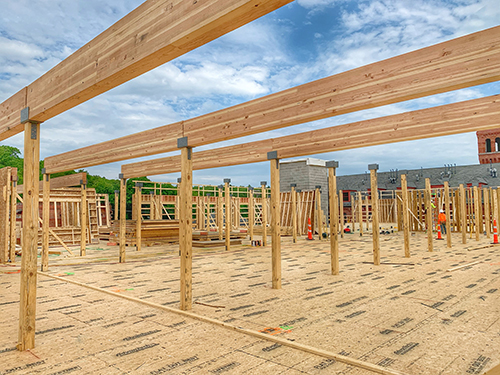- Who We Are
-
Our Work
-
Educational
- Brooks School- George and Evanthea Demoulas Family Boathouse
- Riverbend School - Gym and Schoolhouse
- Lesley University- Animation Studio
- Middlesex School- Bass Arts Pavilion and Danoff Visual Arts Center
- Nashoba Brooks School- Sureau Family Discovery Barn
- The Southport School- Arts and Music Building
- Senior Living
- Hospitality
-
Healthcare
- Partners Urgent Care
- Yale New Haven Health- Medical Office Building
- The Hospital of Central Connecticut - Advanced Wound and Hyperbaric Medicine Center
- Connecticut Children's - Infusion Center and Gastrointestinal Clinic
- Connecticut Children's - Specialty Care Center
- MidState Medical Center- Post-Anesthesia Care Unit Expansion & Renovation
- Commercial
- Specialty Work
-
Educational
- How We Do It
- Our Blog
- Industry Tidbits
- Join Our Family
- Contact Us
Senior Living Construction Trends Impacting Owners and Developers – Part 2
July 31st, 2023
Senior living development and construction is increasingly complex and demanding. Owners and operators need to consider a multitude of factors including market demand and differentiation, attractive program offerings and related amenity space requirements, regulatory mandates, staffing, and of course, financing strategies.
Understanding trends in the planning and construction of senior living facilities is another factor that will help the design and development process move smoother and faster. In Part 1, we looked at the first two trends. They are:
Trend 1: There’s an increasing number of building construction options.
Trend 2: Technology considerations are becoming an earlier design/development focus.
Here are three more construction trends we’re seeing and suggestions on how to make these work for you.
Trend 3: Contrary market forces are real but can be addressed.
As we exit a period where Owners were primarily focused on urgent pandemic considerations, some things haven’t changed. It’s still important to get new housing and services to market as quickly as possible to take advantage of customer demand before it changes.
What has changed is the increasing uncertainty around development, particularly in three areas:
- Acquisition of project capital – interest rates, financial groups becoming more selective, etc.
- Commodity pricing volatility – although broad construction product escalation has eased and is less erratic than it was even six months ago, it’s become increasingly important to have current budget pricing on projects. In spite of this positive trend, the team also needs to consider the impact of specific product lead times as many products are affected by the slowest piece within a worldwide supply chain. For example, here are lead times for a few items currently (in months): electrical switchgear (8-14), structural bar-joists (6-10), and light fixtures (0-4+). Projects need both macro and micro cost/supply tracking.
- Subcontractor and labor shortages – although there are some signs this is easing, quality subcontractors continue to be busy and very selective about what projects they work on.
 Suggestions to make this trend work for you:
Suggestions to make this trend work for you:
- Have a realistic and coordinated development timeline.
- Consider product lead time impacts. Recently we suggested that a project change the structural system from bar-joists to all structural steel. It enabled the project to start 6 months early. Selective pre-ordering of long-lead items is a necessity in this market.
- Set a strong document goal. Highly competitive pricing requires developed plans. Subs take these documents more seriously and it enables the construction group to negotiate better.
- Be ready to close (permits, organization and financial approvals). Since subs hold pricing for a short period, it’s important for the team to get to a “buy-it!” milestone quickly.
Trend 4: Repurposing spaces, in a systematic fashion, is increasingly important.
Incoming residents and their families have high expectations and it’s easier than ever to make comparisons. As a result, repositioning and renovations, including outdoor amenity spaces, are becoming a larger part of campus development. Since it’s unusual for a campus to be able to tackle all that’s desired at once, developing a coordinated phased strategy is essential.
Suggestions to make this trend work for you:
- Use Strategic Planning then Master Facilities Planning to develop and update the general game plan.
- Renovation recommendations: do the early work well (and quickly). To do that, view Project Definition (PD) as a focused stage in the process.
- Identify MAIN “drivers” and MAIN “priorities” clearly (the why and the what).
- PD approaches:
- Have both a narrow “core project” as well as a comprehensive analysis (using alternates).
- Investigate what’s important (due diligence).
- Progress design and budgeting together (include phasing & operations impacts).
- Use a process that builds buy-in and sets up the next step.
Trend 5: The development process is becoming more collaborative.
Assisted living went through a phase in the 1990s where “if you build it, they will come”. It’s obvious that time has passed. Now, each program and building solution is unique and complex. It’s more important than ever to get it right. There’s no “beta testing”! I share with Owners that our team’s goal is to make the building “sing” – so that in 5 or 10+ years, the building is performing well and doing all that we are hoping for today.
Suggestions to make this trend work for you:
Get the right players involved early. Teams are increasingly hiring the architect and construction manager at the same time and then supporting a team environment so that every number counts. Here are some of the benefits:
- Design team factors: benefit from collective intelligence, reduce errors, avoid last-minute changes, produce better and less costly solutions.
- Construction team factors: address constructability virtually, utilize building expertise, produce savings.
- Project factors: save money, avoid start delays, shorten the schedule, improve quality, work as a team.
- Outcomes focus is key.

In summary, here are the senior living construction trends we’re seeing. There are solid ways to address these realities so the development process is more economical and moves smoother and faster.
- Trend 1: There’s an increasing number of building construction options.
- Trend 2: Technology considerations are becoming an earlier design/construction focus.
- Trend 3: Contrary market forces are real but can be addressed.
- Trend 4: Repurposing spaces, in a systematic fashion, is increasingly important.
- Trend 5: The development process is becoming more collaborative.
Contact us to learn how we can help you with your next construction project.










